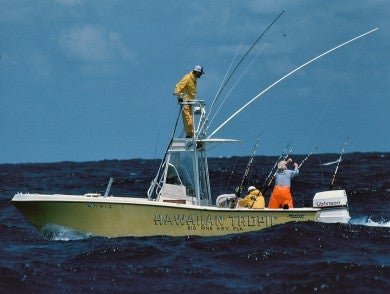Coastal Danger Zones: St. Lucie Inlet, Florida
Bob McNally 08.02.15

The two young Florida anglers who have been lost at sea ventured offshore out of one of the Atlantic Coast’s most dangerous inlets. Nearby is another harrowing pass to the ocean called St. Lucie Inlet.
St. Lucie, like many of the country’s most dangerous inlets, is narrow with shifting sandbars and lots of boat traffic. It’s no place for small boats in heavy east or northeast seas. There’s also not enough channel width for big boats running side-by-side to run the inlet safely, especially in foul weather.
St. Lucie is especially treacherous when the fishing is best during foul, winter weather when many visiting anglers from outside Florida are bent on running offshore for sailfish and other important marine species.
That is when my friend, the late Captain Jim Strader, “made his bones” at St. Lucie Inlet.
On that particular day seas were running 8 to 10 feet and no one was leaving the marina, Jim explained to me.
“That’s when four guys showed up with lots of brag and plenty of cash, and they wanted to go for sails no matter the weather,” Jim said. “They tried to hire me and another captain, a pal of mine on a boat in the slip beside me. I wouldn’t take ‘em, and he wouldn’t either. But they kept upping the charter fee, and finally I told my pal that we could team up on my boat, which was bigger at 30 feet, and we’d be plenty safe. We figured we’d run out the inlet, the guys would get sick, beg to come in, and we’d just come right back with a full day’s double charter fee.”
And that’s what happened. Except the seas built to over 10 feet, and nor’easter waves started stacking big off St. Lucie Inlet during a falling tide, creating a cauldron of wind and whitewater.
“The seas were huge, and the cycle between ‘em short and uneven because of the falling tide,” Jim remembered. “It was so bad everyone put on life jackets, while I watched wave cycles before making my inlet run. We put the charter clients down below in my boat’s cabin. My friend, the other charter captain, stayed down there with them to make sure they didn’t leave the compartment.”
Jim picked a big roller to ride the back of and gunned the single-screw inboard on his boat. He rode the back of the wave perfectly, but only halfway through the inlet. The boat didn’t have enough power to keep speed with the rushing wave, so his old wooden hull boat slid down the backside of that breaker, into the trough, and got caught on the face of the following towering wave. Jim’s boat started to surf down the face of a 12-footer until the stern began to turn, causing the boat to wallow, then broach, rolling it far over, the monstrous wave engulfing the vessel sideways.
What happened next Jim would never forget.
“The wave broke across my broadside boat as it was heeled way over on its side,” he remembered. “I almost got taken overboard by that wave. Then the boat suddenly righted itself, snapping back up like a cork shot from a slingshot. That’s what catapulted me into the ocean, tossing me completely across my boat and through a heavy canvas spray shield.”
Jim’s pal, the other captain, immediately came up on deck, got control of the boat and miraculously guided it through the inlet safely. But there was no going back for Strader, who now was tossed helplessly about in the inlet in gigantic seas. Fortunately another captain on another boat saw what happened and tossed out two long lines with knots tied in at intervals. When he made his inlet run he ran close to Strader, who grabbed one of the lines, and was towed to safety.
“That was the last time I ever owned a single-screw boat, and one that wasn’t powered to the maximum,” Strader said. “You need plenty of boat power for safety speed when running dangerous inlets with plenty of current and high waves.”
